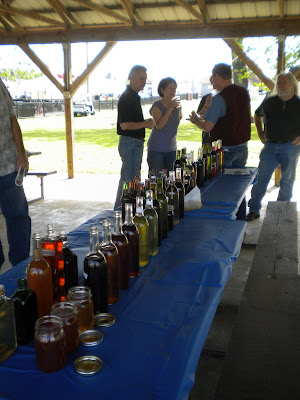Hi Knitters:
I have made quite a bit of progress on my sweater over the last week. As I was knitting I thought of a few things that I have found helpful over the years that I hope you find helpful as well.
Tip #1. Most sweater patterns call for you to knit the back first. I am not sure why that is the case but a while back I started knitting the front first. I find it much easier to get an idea of how the fit is working out. I hold the front up to myself frequently as I knit to check the length and width. I even occasionally will lightly block the front with a little steam while it is still on the needles if I have some doubts about whether I have enough ease around the sides, etc. It's also easier to check your armhole depth, fit around the bust, etc., when working with the front piece.
Tip #2. Once I have finished the front to my liking, I block it before starting the back. This way it is very easy to count the rows. For years I did exactly what the patterns called for and that was to knit according to measurements. For example, knit until garment measures 12 inches and begin armhole shaping. Or continue knitting until armhole measures 9 inches from first bind-off. I do knit the front according to measurements and then check by the holding it up and around me method. But then for the back I actually knit by duplicating the # of rows in the front. Maybe it was me, but I always ended up with the front or back, or armhole being a little bit different length, even though my tape measure said it was the same. There are just too many variables when measuring something that by it's very nature is flexible and stretchy. So, after completing the front, I count rows and make a note of exactly how many rows I have knit to the first increases, the first decreases, the beginning of the armhole shaping, and the first bind-off -- anywhere the back needs to correspond exactly to the front.


Then I knit the back to match exactly to row # instead of measurement. This really helps when it comes to the sewing time because I don't have to ease in extra stitches here and there. Now someone may write me and let me know exactly why it is important to knit the back first and it may be for a very good reason. If so, I will humbly swallow my words, but this is what I have found works really well for me.
Tip #3. Another little tip if you would like to use this method is to put yarn markers at the edge of your work as you count the rows which saves you from having to recount over and over as you knit. I might place a marker every 25 or 50 rows, depending on the project.
Tip #4. I discovered a nice-sized hole in my knitting after I had knit a good bit further than the hole. This one really puzzles me. I didn't discover it until I did a stitch count several rows later and found I was off by one. When I spread the piece out to have a look at where I lost the stitch I saw the hole. There was no dropped stitch, the hole was just
there, right smack in the middle with no loose end anywhere to be found. I can't account for the mysterious little circle. I guess that's what I get for knitting while mesmerized by Orange County Housewife Peggy's amazingly orchestrated gourmet dinner party on her fabulous candle-lit patio with her disastrously dysfunctional guest list.
There it is in all its holey glory. Moral of the story and Tip #4: When watching reality TV, check your work at every commercial break!
Anyway, I had knit enough that I didn't want to tear back, but because it wasn't actually a dropped stitch, I couldn't weave it back up to the current row with a crochet hook. After pondering my options I decided to try weaving through the stitches immediately before and after the hole on the back of the fabric, seeing if I could just close up the hole by snugging the stitches close together.
I threaded a length of yarn on a tapestry needle and wove it in and out of the stitches to the right and left of the hole, following over the path of the yarn.
It was a little like doing the "kitchener" stitch or graftin. When I got to the hole, I continued into the next stitch just after it and gently snugged it together. I wound my way through three or four more stitches and then cut the ends leaving a little length so the ends won't pop through to the front. It's not perfect but I decided that since it is in the back in a not-very-noticeable spot that I would knit on without frogging.
I am liking the sweater a lot so far. The yarn is so cool and summery. But am a bit concerned I may have overdone it on the depth of the vee. We'll see when it's all sewn together. I can always add a few buttons or maybe a knitted inset if necessary.
Tomorrow we are headed to the Kolache Festival in Prague, Oklahoma. It will be my first Kolache Festival, but not my first kolache. I tried one for the first time last year at festival time when a friend brought one home for me and have decided kolaches are worth the drive. All of the churches in Prague bake for many months in preparation for the festival. My daughter's new sister-in-law helps with the baking at the Baptist Church where she said it is not unusual for them to bake 2400 dozen in the months just before festival time. Each of the town churches claims to have the best recipe and I am going to do my part in trying as many as possible.
The drive should give me plenty of knitting time tomorrow.
Happy Knitting, Josey




















































